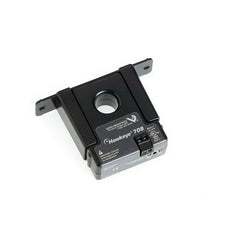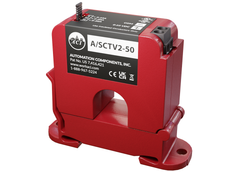Scroll to view all
current sensors
View Details


H608 | Mini Split-Core | Adj. | Range: 0.50-175AAC Output: N.O. | 1.0A | Veris
Brand: Veris
SKU: H608
View Details


H221 | Split Core | Span Adj. | Range: 0-300AAC | Output: 4-20mA | Loop | Veris
Brand: Veris
SKU: H221
View Details


H938 | Current Switch / Relay Combo | Split Core | Adj. | SPST | Veris
Brand: Veris
SKU: H938
View Details


H721LC | Solid Core | Range:0-10 | 0-20 | 0-40AAC Sw Select | Output:4-20mA | Veris
Brand: Veris
SKU: H721LC
View Details


H900 | Split Core | Fixed | Range: 1.5-200AAC | Output: N.O. | 1.0A@30V | Veris
Brand: Veris
SKU: H900
View Details


H600 | Mini Split-Core | Fixed | Range .15-200AAC | N.O. | 1A@30VAC / DC | Veris
Brand: Veris
SKU: H600
View Details


H800 | Solid Core | Fixed | Range: 0.25-200AAC | Output: N.O. | 1.0A@30V | Veris
Brand: Veris
SKU: H800
View Details


C-2320-L | Preset, 0.45-50A, split core | Senva Sensors
Brand: Senva Sensors
SKU: C-2320-L
View Details


H701 | Solid Core | Adj. | Range: 1-135AAC | Output: N.O. | 1.0A@30VAC / | Veris
Brand: Veris
SKU: H701
View Details


H948 | Current Switch / Relay Combo | Split Core | Adj. | SPDT | Veris
Brand: Veris
SKU: H948
View Details


H609 | Mini Split Core | Adj. | 1.25-50AAC | Output:N.O. | 0.2A@120VAC | Veris
Brand: Veris
SKU: H609
View Details


C-2344 | Analog 0-10VDC, 30 / 60 / 120A, split core | Senva Sensors
Brand: Senva Sensors
SKU: C-2344
View Details


C-2343-L | Analog 0-5VDC, 5 / 10 / 20A, split core | Senva Sensors
Brand: Senva Sensors
SKU: C-2343-L
View Details


H622-10 | Current Xducer, Split-Core, 0-10A, 0-5VDC | Veris
Brand: Veris
SKU: H622-10
View Details


H808 | Mini Solid Core | Adj | Range:0.75-50AAC | Output:N.O. | 1.0A@30V | Veris
Brand: Veris
SKU: H808
View Details


H720 | Solid Core | Span Adj. | VFD | Range: 0-200AAC | Output:4-20mA | Veris
Brand: Veris
SKU: H720
View Details


H606 | Mini Split Core | Adj. | Range: 1.25-50AAC | Output: N.C. | 0.1A | Veris
Brand: Veris
SKU: H606
View Details


RIBMX24BF | Panel 4in Internal Fixed Current Sensor + Relay 20Amp SPDT 24Vac / dc | Functional Devices
Brand: Functional Devices
SKU: RIBMX24BF
View Details


REE-5525 | Relay: Proportional to Tri-State / Floating, 0-10VDC Input | KMC
Brand: KMC
SKU: REE-5525
View Details


H822 | Solid Core | Range: 0-10AAC Factory Set | Output: 0-5VDC | Veris
Brand: Veris
SKU: H822
View Details


C-1203 | Analog 0-5VDC, 0-15A, solid core - mini | Senva Sensors
Brand: Senva Sensors
SKU: C-1203
View Details


RIBXLCRA | Enclosed Solid-Core AC Sensor Adjustable + 10Amp SPDT Relay 10-30Vac / dc | Functional Devices
Brand: Functional Devices
SKU: RIBXLCRA
Committed to customer satisfaction
as experts in Current Sensors
Recently Viewed
Popular Products
View all →
AMB24-3 | Damper Actuator | 180 in-lb | Non-Spg Rtn | 24V | On/Off/Floating Point | Belimo
Brand: Belimo
SKU: AMB24-3
LMB24-3-T | Damper Actuator | 45 in-lb | Non-Spg Rtn | 24V | On/Off/Floating Point | Belimo
Brand: Belimo
SKU: LMB24-3-T
EISK5-100T | 5-port 10BASE-T/100BASE-TX Skorpion switch, DIN-rail mount | Contemporary Controls
Brand: Contemporary Controls
SKU: EISK5-100T
FSLF120 US | Fire & Smoke Actuator | 30 in-lb | Spg Rtn | 120V | On/Off | 1m Cable | Belimo
Brand: Belimo
SKU: FSLF120 US
LF120 US | Damper Actuator | 35 in-lb | Spg Rtn | 120V | On/Off | Belimo
Brand: Belimo
SKU: LF120 US
iO-WR | Wireless Relay | iO HVAC Controls
Brand: iO HVAC Controls
SKU: iO-WR
ZTH US | Handheld programming tool with ZK1-GEN | ZK2-GEN and ZK6-GEN. | Belimo
Brand: Belimo
SKU: ZTH US
IO-WRP | WIRELESS RELAY PLUS | iO HVAC Controls
Brand: iO HVAC Controls
SKU: IO-WRP
